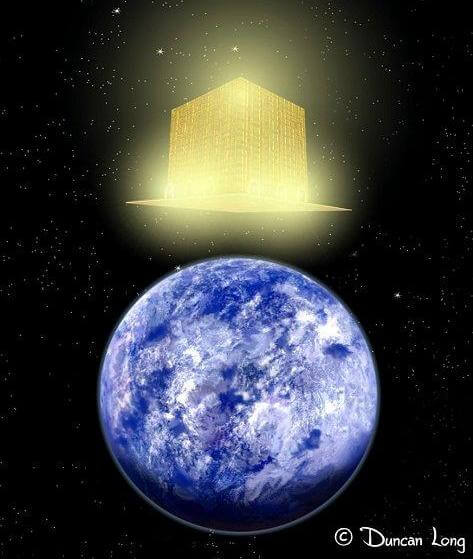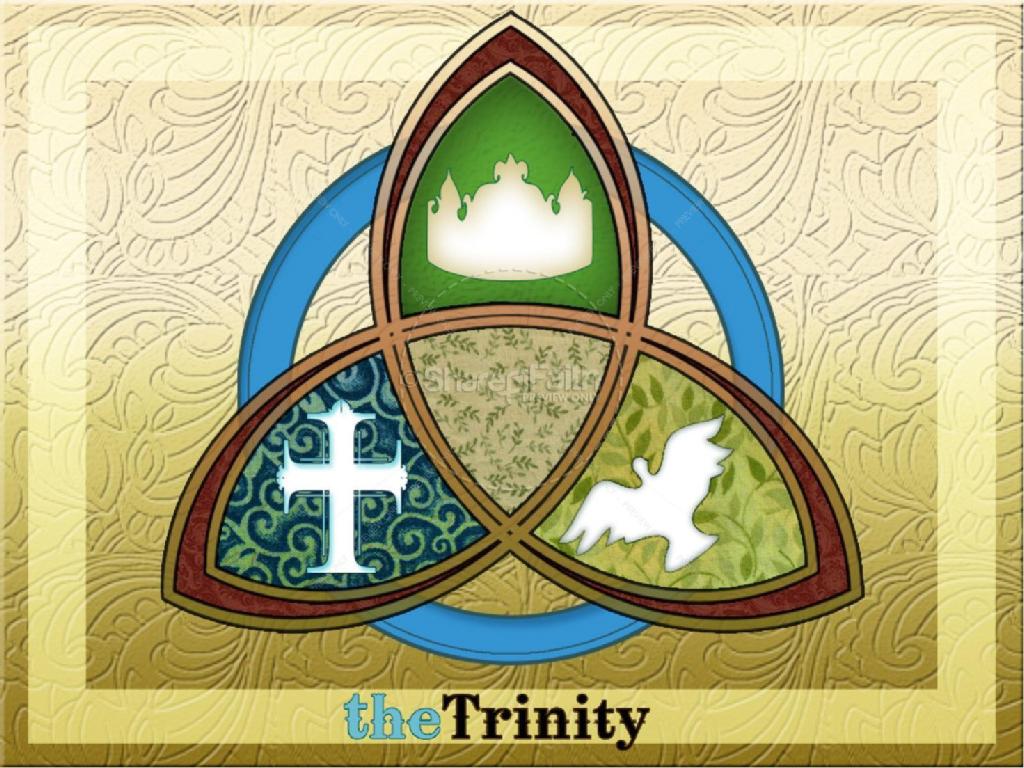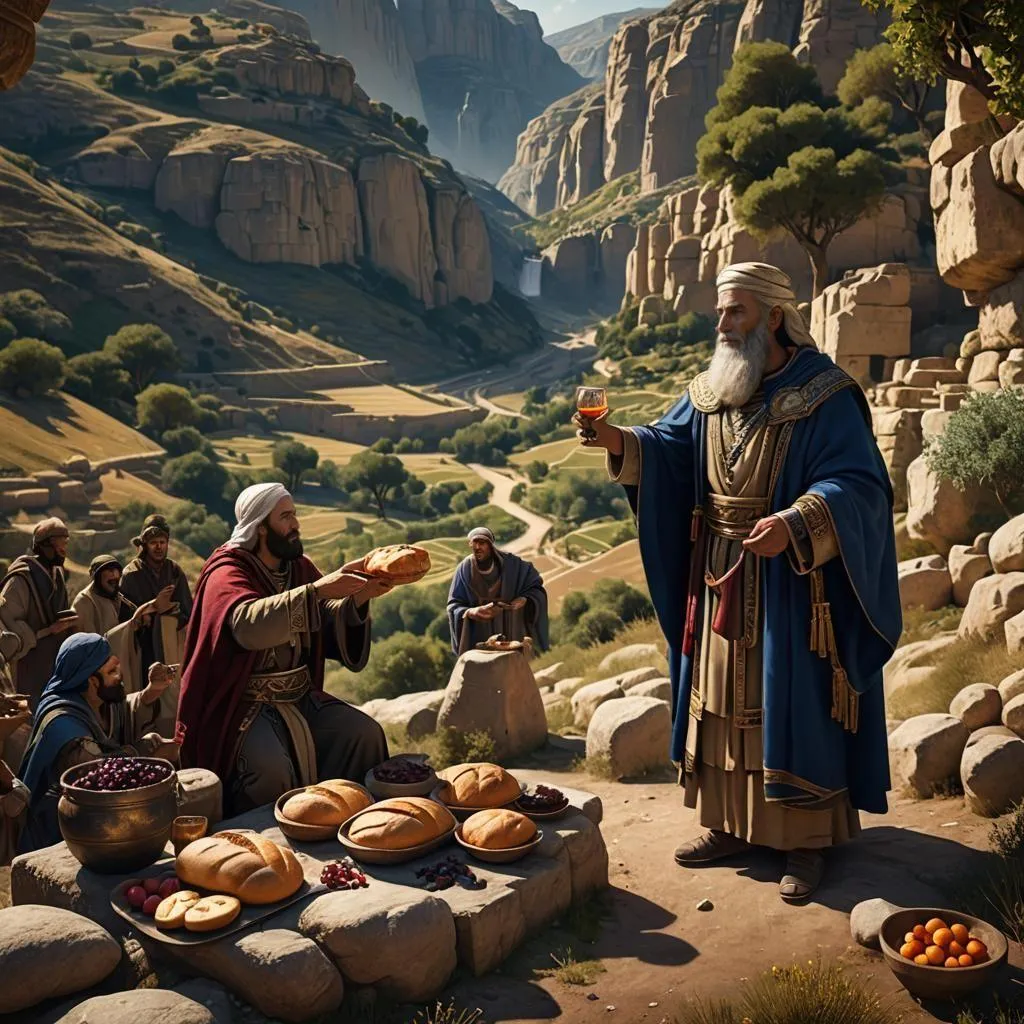The Coming of Jesus: Daniel's 70 Weeks

Series Index
- The Coming of Jesus: Introduction
- The Coming of Jesus: Daniel's 70 Weeks
- The Coming of Jesus: Coming on the clouds
- The Coming of Jesus: The Olivet Discourse – Part 1
- The Coming of Jesus: The Olivet Discourse – Part 2
- The Coming of Jesus: Revelation Fulfilled?
- The Coming of Jesus: Our Future Hope - What Now?
Daniel's 70 Weeks
To fully understand Jesus's first, and indeed what is commonly called his "Second Coming," we need to understand the book of Daniel. This prophetic books give many details and glimpses into the future about coming kingdoms, rulers and above all, the Messiah. I'm going to be focussing on just one part of the book, chapter nine, often referred to as "Daniel's 70 Weeks". But just what is "Daniel's 70 Weeks" you might be asking as you read this. For those unfamiliar with Old Testament prophecy, it is a prophetic vision that Daniel was given from God, and interpreted by the angel Gabriel. You can read the prophecy in full below:
Dan 9: 20-27 (NRSV)
While I was speaking, and was praying and confessing my sin and the sin of my people Israel, and presenting my supplication before the Lord my God on behalf of the holy mountain of my God— while I was speaking in prayer, the man Gabriel, whom I had seen before in a vision, came to me in swift flight at the time of the evening sacrifice. He came and said to me, “Daniel, I have now come out to give you wisdom and understanding. At the beginning of your supplications a word went out, and I have come to declare it, for you are greatly beloved. So consider the word and understand the vision:
“Seventy weeks are decreed for your people and your holy city: to finish the transgression, to put an end to sin, and to atone for iniquity, to bring in everlasting righteousness, to seal both vision and prophet, and to anoint a most holy place. Know therefore and understand: from the time that the word went out to restore and rebuild Jerusalem until the time of an anointed prince, there shall be seven weeks; and for sixty-two weeks it shall be built again with streets and moat, but in a troubled time. After the sixty-two weeks, an anointed one shall be cut off and shall have nothing, and the troops of the prince who is to come shall destroy the city and the sanctuary. Its end shall come with a flood, and to the end there shall be war. Desolations are decreed. He shall make a strong covenant with many for one week, and for half of the week he shall make sacrifice and offering cease; and in their place shall be an abomination that desolates, until the decreed end is poured out upon the desolator.”
Now, in this prophecy, it speaks of "weeks" (or literally, "sevens") – 70 in total, which if taken at face value would only be just over a year in length. This would be a very short time to do all that is spoken of by the angel — especially the rebuilding of a city!
The prophecy in Daniel gave the time span for the rebuilding of the city and even mentions that it will be in a "troubled time" as Gabriel told Daniel, which we can see happen in the book of Nehemiah in about 444 BC (around 94 years later):
Nehemiah 4:7-8
But when Sanballat and Tobiah and the Arabs and the Ammonites and the Ashdodites heard that the repairing of the walls of Jerusalem was going forward and the gaps were beginning to be closed, they were very angry, and all plotted together to come and fight against Jerusalem and to cause confusion in it. (cf. Neh 4:16-18; Ezra 3:3)
The is a prophetic metaphor for years – each day equals one year. You may wonder how the "sevens" or "week" equals 7 years, and by looking at other examples of prophetic language in the Bible, we can find two other places where one day is equal to one year in a prophetic sense: Ez 4:6 and Num 14:34. There's also two other places where one day is equalled with one thousand years: Ps 90:4 and 2 Pet 3:8 – unlike the previous examples, these aren't spoken of in a prophecy or vision as to have a specific time meaning, but are rather hyperbole to make a point, as the surrounding context of those verses will show.
If we were to calculate Daniel's prophecy based on 1000 years to each day, it would cover a timeframe of 70,000 years instead of 490 – which is just slightly ridiculous!
So lets break down the prophecy to see what's going on and being said:
"Seventy weeks are decreed for your people and your holy city" — 70 weeks, or 490 years (70x7), have been decreed by God as the time set for the following things to take place for the Jews and Jerusalem. These things can be split up into six parts:
- To finish the transgression
- To put an end to sin
- To atone for iniquity
- To bring in everlasting righteousness
- To seal both vision and prophet
- To anoint a most holy place (Heb. or "thing" or "one").
The angel Gabriel then gives a brief overview of how all of these things will happen, when the seventy week countdown begins, and the timescale for each part. The nation of Israel were basically on probation from God to get their act together; they have 490 years to get right with God, which is point 1. Then follows points 2-6. This prophecy is actually very precise and specific!
...from the time that the word went out to restore and rebuild Jerusalem until the time of an anointed prince, there shall be seven weeks; and for sixty-two weeks it shall be built again with streets and moat, but in a troubled time. After the sixty-two weeks, an anointed one shall be cut off and shall have nothing, and the troops of the prince who is to come shall destroy the city and the sanctuary.
I'm going to include this same quote from the NIV translation too (all other quotes are NRSV), as it keeps the original wording of "sevens" instead of using "weeks", which I find makes the grammar of the sentence flow a little better:
From the time the word goes out to restore and rebuild Jerusalem until the Anointed One, the ruler, comes, there will be seven ‘sevens,’ and sixty-two ‘sevens.’ It will be rebuilt with streets and a trench, but in times of trouble.
This in total means that there are to be 483 years from when the word "goes out" to start restoration on Jerusalem. I point this out because of the way the English translations make the initial seven and the sixty-two sevens appear as separate events, as in the NRSV ("there shall be seven weeks; and for sixty-two weeks...") whereas the NIV quote doesn't come across that way, and neither does it in some other versions, such as the KJV. I looked this up in a Hebrew interlinear (since I can't read ancient Hebrew) and the flow of the sentence is more akin to the NIV, KJV etc., with a Sof passuk (ie. a full stop/period) marking the end of the sentence at the end of verse 25. But I'm not a Hebrew expert so I may be overlooking other aspects of grammar here.
What has this got to do with Jesus?
Now you may be asking, what has all this got to do with the "Second Coming?" Well, in order to fully understand when the return and "the end" is to take place, we must first understand the timing of Daniel's prophecy about the Messiah as his first coming and death, and then what's oftern thought to be his return are all wrapped up in this 70 weeks.
"From the time the word went out" is often related to King Cyrus, who gave the initial decree that allowed the Jews to return to Jerusalem to begin rebuilding their temple (cf. 2 Chron. 36:23; Ezra 1:2-5). This is assumed because Cyrus was prophesied about by Isaiah 150-200 years before he was born. The amazing thing about this prophecy is that Isaiah actually named Cyrus and that he would do this! Check it out:
Isaiah 44:28
...who says of Cyrus, “He is my shepherd,
and he shall carry out all my purpose”;
and who says of Jerusalem, “It shall be rebuilt,”
and of the temple, “Your foundation shall be laid.”
But what is often overlooked in this is that Cyrus only gives a decree to rebuild the temple. We see this fulfilled in Ezra 3:8-13 which tells of when the foundations were laid after the Jews returned to Jerusalem following Cyrus's decree. Josephus, a first century Jewish historian, gives a nice little insight into this aspect of Jewish history (Antiquities 11:1,2) when he recounts that King Cyrus didn't realise this was written but when it was shown to him, he then had a desire to go about and fulfil it - despite being a Persian king who didn't even know nor worship the God of the Jews (Isa 45:5)!
So when did the seventy week clock begin ticking, if not with Cyrus? There are four decrees by three kings to the Jews concerning the rebuilding of the temple and the city, over a period of time: Cyrus, Darius and Artaxerxes (twice, although there is some dispute over whether there was a second king with the same name later on).
But is it the decree of Artaxerxes (Ezra 7:11-26) in which the Jewish people were allowed to go back to Jerusalem with the blessing of the king, so that they may restore it fully. This happened in the 7th year of his reign (Ezra 7:8), which according to historical records, would have been 457 BC.
As a point of interest, there is another way in which these initial 7 weeks and 62 weeks can be read which could also explain why the "weeks" are phrased in two parts ("until the time of an anointed prince, there shall be seven weeks; and for sixty-two weeks..."). This first anointed price could well reference Cyrus (as "anointed" doesn't always mean the Messiah in the Saviour sense), and the "word" that went out could be a reference to Jeremiah's prophecy about the Babylonian captivity (which is during the time that Daniel was written). Jeremiah prophesied about Jerusalem about 587 BC, which would in fact be 49 years before Cyrus gave his decree, around 538 BC. The break in the time, and then continuing with "and for sixty-two weeks it shall be built..." would still begin when the rebuilding actually took place, in the reign of Artaxerxes, still leading us up until the time of Jesus.
Linking into the New Testament
It is generally accepted that Jesus was baptised around 26 or 27 AD, given the timescales and points in history the authors of Scripture give us (eg. Luke 3:1). This now brings us from "the time that the word went out to restore and rebuild Jerusalem" right up until "after the sixty-two weeks" when the next "anointed one" appears in the prophecy, as when Jesus was baptised it was then he was anointed by the Holy Spirit to begin his ministry (Matt 3:16-17; Acts 10:38). As an aside for those reading who may not realise the connection: Messiah is the Hebrew word for "anointed," and Christ is the Greek version of that Hebrew word – hence Jesus Christ, or Jesus the Messiah (although, not all who were anointed were thought or expected to be the promised Saviour-Messiah).
This timescale brings us perfectly up to the 69 "weeks" of Daniel's prophecy, which is 483 years leaving only the remaining "week" to go.
There is a 'pause' here, similar to the first 7 weeks, in the way the angel Gabriel phrases the prophecy to Daniel in verse 26: "After the sixty-two weeks, an anointed one shall be cut off and shall have nothing" – so the initial 483 years brings us up to the next appearance of the Anointed One, and then after this he shall be "cut off", ie. killed. Jesus was crucified after about 3 years of ministry.
Before getting into that last 7 year period, I'd just like to point out some aspects of the Gospels and Galatians which should hopefully make more sense now in light of Daniel's prophecy and its timing:
Gal 4:4 But when the fullness of time had come, God sent his Son, born of a woman, born under the law... (emphasis mine)
Mark 1:14-15 Now after John was arrested, Jesus came to Galilee, proclaiming the good news of God, and saying, “The time is fulfilled, and the kingdom of God has come near; repent, and believe in the good news.” (emphasis mine)
Jesus began his ministry at that time because it was when the "time [was] fulfilled", referencing Daniel's prophecy (which would also "seal both vision and prophet" about this event; v.24) , which his original audience would have understood. The Jewish people had that time while Jesus was with them to repent and turn back to God and enter his eternal kingdom which was promised to the Messiah – the kingdom which Daniel also prophesied about in Daniel chapter two, that would be founded not by human hands, and which would last forever. That was the time which God had given his people, and those who rejected it would suffer what was prophesied about in the final "week".
Dan 2:44
And in the days of those kings the God of heaven will set up a kingdom that shall never be destroyed, nor shall this kingdom be left to another people. It shall crush all these kingdoms and bring them to an end, and it shall stand forever
2 Peter 1:11
For in this way, entry into the eternal kingdom of our Lord and Savior Jesus Christ will be richly provided for you
Jn 18:36
Jesus answered, “My kingdom is not from this world. If my kingdom were from this world, my followers would be fighting to keep me from being handed over to the Jews. But as it is, my kingdom is not from here.
The Final Week
There is some contention about this final seven years. The details about what happens during that time are divided in half: a ruler will come to destroy for the first half (3.5 years), and then war will ensue until the end, which will also be this ruler's end too when the final 3.5 years are complete.
Some say that it is still yet to come, in some far-flung future, as the "prophetic clock" stopped when Jesus was killed. I suspect if you've ever been taught anything about the "End Times," that is what you believe or expect, especially if you have read or watched the Left Behind books or films which are based heavily on a futurist interpretation of Daniel, Revelation and the Olivet Discourse.
But it may surprise you to know that this isn't the only interpretation or school of thought, despite how popular this view is. I used to believe that this was what was going to happen, that it could happen at any moment as "Jesus is coming soon!" along with great tribulation and "armageddon" as people often proclaim. But after studying this topic for quite some time now, I've found that it doesn't reconcile with what the Scriptures say, or what Jesus taught, nor what history shows, and thus have had to adjust my views.
Lets have a look at what is to happen in the final seven years:
Dan 9:26-27
After the sixty-two weeks, an anointed one shall be cut off and shall have nothing, and the troops of the prince who is to come shall destroy the city and the sanctuary. Its end shall come with a flood, and to the end there shall be war. Desolations are decreed. He shall make a strong covenant with many for one week, and for half of the week he shall make sacrifice and offering cease; and in their place shall be an abomination that desolates, until the decreed end is poured out upon the desolator.
Now some say that since Jesus' ministry was about 3 and a half years long, that this was the final week and why the sacrifices were ceased. On the face of it this seems to make sense, as the sacrificial death of Jesus was the be the final sacrifice for sins for all time in the eyes of God, thus any other animal sacrifices aren't accepted. While Jesus's death did fulfil other aspects of this prophecy: "an anointed one shall be cut off ... to put an end to sin, and to atone for iniquity, to bring in everlasting righteousness" which the New Testament authors were clearly aware of and saw fulfilled in Jesus, I won't write them all out here but will give references – John 1:29; 1 Cor 1:30; 2 Cor 5:17-19,21; Romans 3:21-22 ; Romans 5:17-19; Heb 13:12; Heb 9:15; 1 Peter 2:24; Col 1:20, plus many more.
I will quote one passage though, which I think summarises the fulfillment of Jesus in Daniel's prophecy:
Heb 9:26b-25
But as it is, he has appeared once for all at the end of the age to remove sin by the sacrifice of himself.
Not only does this state that the early Christians saw Jesus as being the ultimate sacrifice to remove sins for all time, and give those who believe in him everlasting righteousness, but that they also recognised the times as being "the end of the age". I will be going more into that topic later in this series.
So while I do see a fulfillment here in part, and agree with the New Testament authors that Jesus's sacrifice did put an end to the need for animal sin sacrifices, however I don't believe that this is what Dan 9:26-27 is all about, as the Jews will have continued to sacrifice in the temple as they always did, even after Jesus's death.
No, this part is also what Jesus prophesied about in Matt 24:15 "So when you see the desolating sacrilege standing in the holy place, as was spoken of by the prophet Daniel" and also in verse 30, "they will see ‘the Son of Man coming on the clouds of heaven’" which is also a reference to the book of Daniel chapter seven: "As I watched in the night visions, I saw one like a son of man coming with the clouds of heaven."
Here, Jesus also says that the temple will be destroyed too, which is what this final week in Daniel is also saying: "the prince ... shall destroy the city and the sanctuary" – contrast this with Matt 24:1-2.
Some reading this now may be thinking of something else Jesus said, "But about that day and hour no one knows" — this can still be true despite the preciseness of Daniel's prophecy, simply because the 70 weeks appear to have some time breaks which leave it open to happen only when certain events are in play – by which point the signs of what's coming will be obvious yet still not definite.
"After the sixty-two weeks ... the troops of the prince who is to come shall destroy the city..." – there's an indefinite period of time here, which is why Jesus told his disciples, "when you see all these things, you know that he is near..."
I'll be discussing Matthew 24-25 in more detail in Part 3 of this series; the next part will be looking at what exactly "coming on the clouds of heaven" means in terms of it's usage in the Old Testament prophetic texts, and how the disciples and those listening to Jesus would have understood it, as all these phrases link the New to the Old Testament. As 1st century Jews who knew their Scriptures, they would have undoubtedly have heard it differently to how we do in a 21st century context with all of our "End Times" baggage and bias.
Feel free to leave a comment below and share your thoughts!
Further reading:
- http://www.biblicalstudies.com/bstudy/eschatology/daniel.htm
- http://www.daniels70weeks.com/
- http://www.patmospapers.com/daniel.htm
- http://biblehub.com/timeline/ezra/1.htm
- http://biblehub.com/timeline/nehemiah/1.htm
- http://www.scripture4all.org/OnlineInterlinear/OTpdf/dan9.pdf
- http://www.ccel.org/j/josephus/works/ant-11.htm
- http://www.tedmontgomery.com/bblovrvw/C_11b.html
- http://cicministry.org/commentary/issue5.htm
- http://jesusprophecies.wordpress.com/2011/03/07/to-bring-in-everlasting-righteousness/
- http://www.quodlibet.net/articles/hall-sacrifice.shtml
Leave a comment Like Back to Top Seen 2.7K times Liked 2 times
Enjoying this content?
Support my work by becoming a patron on Patreon!
By joining, you help fund the time, research, and effort that goes into creating this content — and you’ll also get access to exclusive perks and updates.
Even a small amount per month makes a real difference. Thank you for your support!
Subscribe to Updates
If you enjoyed this, why not subscribe to free email updates and join over 864 subscribers today!
My new book is out now! Order today wherever you get books
Recent Posts
Luke J. Wilson | 19th August 2025 | Fact-Checking
A poetic post has been circulating widely on Facebook, suggesting that our anatomy mirrors various aspects of Scripture. On the surface it sounds inspiring, but when we take time to weigh its claims, two main problems emerge. The viral post circulating on Facebook [Source] First, some of its imagery unintentionally undermines the pre-existence of Christ, as if Jesus only “held the earth together” for the 33 years of His earthly life. Second, it risks reducing the resurrection to something like biological regeneration, as if Jesus simply restarted after three days, instead of being raised in the miraculous power of God. Alongside these theological dangers, many of the scientific claims are overstated or symbolic rather than factual. Let’s go through them one by one. 1. “Jesus died at 33. The human spine has 33 vertebrae. The same structure that holds us up is the same number of years He held this Earth.” The human spine does generally have 33 vertebrae, but that number includes fused bones (the sacrum and coccyx), and not everyone has the same count. Some people have 32 or 34. More importantly, the Bible never says Jesus was exactly 33 when He died — Luke tells us He began His ministry at “about thirty” (Luke 3:23), and we know His public ministry lasted a few years, but His precise age at death is a tradition, not a biblical statement. See my other recent article examining the age of Jesus here. Theologically, the phrase “the same number of years He held this Earth” is problematic. Jesus did not hold the world together only for 33 years. The eternal Word was with God in the beginning (John 1:1–3), and “in Him all things hold together” (Colossians 1:17). Hebrews says He “sustains all things by His powerful word” (Hebrews 1:3). He has always upheld creation, before His incarnation, during His earthly ministry, and after His resurrection. To imply otherwise is to risk undermining the pre-existence of Christ. 2. “We have 12 ribs on each side. 12 disciples. 12 tribes of Israel. God built His design into our bones.” Most people do have 12 pairs of ribs, though some are born with an extra rib, or fewer. The number 12 is certainly biblical: the 12 tribes of Israel (Genesis 49), the 12 apostles (Matthew 10:1–4), and the 12 gates and foundations of the New Jerusalem (Revelation 21). But there’s no biblical connection between rib count and these symbolic twelves. This is a case of poetic association, not design woven into our bones. The only real mention of ribs in Scripture is when Eve is created from one of Adam’s ribs in Genesis 2:21–22, which has often led to the teaching in some churches that men have one less rib than women (contradicting this new claim)! 3. “The vagus nerve runs from your brain to your heart and gut. It calms storms inside the body. It looks just like a cross.” The vagus nerve is real and remarkable. It regulates heart rate, digestion, and helps calm stress, and doctors are even using vagus nerve stimulation as therapy for epilepsy, depression, and inflammation showing it really does “calm storms” in the body. But it does not look like a cross anatomically. The language about “calming storms” may echo the way Jesus calmed the storm on the Sea of Galilee (Mark 4:39), but here again the poetic flourish stretches science (and Scripture) beyond what’s accurate. 4. “Jesus rose on the third day. Science tells us that when you fast for 3 days, your body starts regenerating. Old cells die. New ones are born. Healing begins. Your body literally resurrects itself.” There’s a serious theological problem here. To equate Jesus’ resurrection with a biological “regeneration” after fasting is to misrepresent what actually happened. Fasting can indeed trigger cell renewal and immune repair, but it cannot bring the dead back to life. It’s still a natural process that happens...
Luke J. Wilson | 08th July 2025 | Islam
“We all worship the same God”. Table of Contents 1) Where YHWH and Allah Appear Similar 2) Where Allah’s Character Contradicts YHWH’s Goodness 3) Where Their Revelations Directly Contradict Each Other 4) YHWH’s Love for the Nations vs. Allah’s Commands to Subjugate 5) Can God Be Seen? What the Bible and Qur’an Say 6) Salvation by Grace vs. Salvation by Works Conclusion: Same God? Or Different Revelations? You’ve heard it from politicians, celebrities, and even some pastors. It’s become something of a modern mantra, trying to shoehorn acceptance of other beliefs and blend all religions into one, especially the Abrahamic ones. But what if the Bible and Qur’an tell different stories? Let’s see what their own words reveal so you can judge for yourself. This Tweet recently caused a stir on social media 1) Where YHWH and Allah Appear Similar Many point out that Jews, Christians, and Muslims share a belief in one eternal Creator God. That’s true — up to a point. Both the Bible and Qur’an describe God as powerful, all-knowing, merciful, and more. Here’s a list comparing some of the common shared attributes between YHWH and Allah, with direct citations from both Scriptures: 26 Shared Attributes of YHWH and Allah According to the Bible (NRSV) and the Qur’an Eternal YHWH: “From everlasting to everlasting you are God.” — Psalm 90:2 Allah: “He is the First and the Last…” — Surah 57:3 Creator YHWH: “In the beginning God created the heavens and the earth.” — Genesis 1:1 Allah: “The Originator of the heavens and the earth…” — Surah 2:117 Omnipotent (All-Powerful) YHWH: “Nothing is too hard for you.” — Jeremiah 32:17 Allah: “Allah is over all things competent.” — Surah 2:20 Omniscient (All-Knowing) YHWH: “Even before a word is on my tongue, O LORD, you know it.” — Psalm 139:4 Allah: “He knows what is on the land and in the sea…” — Surah 6:59 Omnipresent (Present Everywhere) YHWH: “Where can I go from your Spirit?” — Psalm 139:7–10 Allah: “He is with you wherever you are.” — Surah 57:4 Holy YHWH: “Holy, holy, holy is the LORD of hosts.” — Isaiah 6:3 Allah: “The Holy One (Al-Quddus).” — Surah 59:23 Just YHWH: “A God of faithfulness and without injustice.” — Deuteronomy 32:4 Allah: “Is not Allah the most just of judges?” — Surah 95:8 Merciful YHWH: “The LORD, merciful and gracious…” — Exodus 34:6 Allah: “The Most Gracious, the Most Merciful.” — Surah 1:1 Compassionate YHWH: “As a father has compassion on his children…” — Psalm 103:13 Allah: “He is the Forgiving, the Affectionate.” — Surah 85:14 Faithful YHWH: “Great is your faithfulness.” — Lamentations 3:22–23 Allah: “Indeed, the promise of Allah is truth.” — Surah 30:60 Unchanging YHWH: “For I the LORD do not change.” — Malachi 3:6 Allah: “None can change His words.” — Surah 6:115 Sovereign YHWH: “The LORD has established his throne in the heavens…” — Psalm 103:19 Allah: “Blessed is He in whose hand is dominion…” — Surah 67:1 Loving YHWH: “God is love.” — 1 John 4:8 Allah: “Indeed, my Lord is Merciful and Affectionate (Al-Wadud).” — Surah 11:90 Forgiving YHWH: “I will not remember your sins.” — Isaiah 43:25 Allah: “Allah forgives all sins…” — Surah 39:53 Wrathful toward evil YHWH: “The LORD is a jealous and avenging God…” — Nahum 1:2 Allah: “For them is a severe punishment.” — Surah 3:4 One/Unique YHWH: “The LORD is one.” — Deuteronomy 6:4 Allah: “Say: He is Allah, One.” — Surah 112:1 Jealous of worship YHWH: “I the LORD your God am a jealous God.” �...
Luke J. Wilson | 05th June 2025 | Blogging
As we commemorated the 500th anniversary of the Protestant Reformation this year, the familiar image of Martin Luther striding up to the church door in Wittenberg — hammer in hand and fire in his eyes — has once again taken centre stage. It’s a compelling picture, etched into the imagination of many. But as is often the case with historical legends, closer scrutiny tells a far more nuanced and thought-provoking story. The Myth of the Door: Was the Hammer Ever Raised? Cambridge Reformation scholar Richard Rex is one among several historians who have challenged the romanticised narrative. “Strangely,” he observes, “there’s almost no solid evidence that Luther actually went and nailed them to the church door that day, and ample reasons to doubt that he did.” Indeed, the first image of Luther hammering up his 95 Theses doesn’t appear until 1697 — over 180 years after the fact. Eric Metaxas, in his recent biography of Luther, echoes Rex’s scepticism. The earliest confirmed action we can confidently attribute to Luther on 31 October 1517 is not an act of public defiance, but the posting of two private letters to bishops. The famous hammer-blow may never have sounded at all. Conflicting Accounts Philip Melanchthon, Luther’s successor and first biographer, adds another layer of complexity. He claimed Luther “publicly affixed” the Theses to the door of All Saints’ Church, but Melanchthon wasn’t even in Wittenberg at the time. Moreover, Luther himself never mentioned posting the Theses publicly, even when recalling the events years later. Instead, he consistently spoke of writing to the bishops, hoping the matter could be addressed internally. At the time, it was common practice for a university disputation to be announced by posting theses on church doors using printed placards. But no Wittenberg-printed copies of the 95 Theses survive. And while university statutes did require notices to be posted on all church doors in the city, Melanchthon refers only to the Castle Church. It’s plausible Luther may have posted the Theses later, perhaps in mid-November — but even that remains uncertain. What we do know is that the Theses were quickly circulated among Wittenberg’s academic elite and, from there, spread throughout the Holy Roman Empire at a remarkable pace. The Real Spark: Ink, Not Iron If there was a true catalyst for the Reformation, it wasn’t a hammer but a printing press. Luther’s Latin theses were swiftly reproduced as pamphlets in Basel, Leipzig, and Nuremberg. Hundreds of copies were printed before the year’s end, and a German translation soon followed, though it may never have been formally published. Within two weeks, Luther’s arguments were being discussed across Germany. The machinery of mass communication — still in its relative infancy — played a pivotal role in what became a theological, political, and social upheaval. The Letters of a Conscientious Pastor Far from the bold revolutionary of popular imagination, Luther appears in 1517 as a pastor deeply troubled by the abuse of indulgences, writing with respectful concern to those in authority. In his letter to Archbishop Albrecht of Mainz, he humbly addresses the archbishop as “Most Illustrious Prince,” and refers to himself as “the dregs of humanity.” “I, the dregs of humanity, have so much boldness that I have dared to think of a letter to the height of your Sublimity,” he writes — hardly the voice of a man trying to pick a fight. From Whisper to Roar Luther’s initial appeal through formal channels was, predictably, ignored. He was advised not to make trouble. But as opposition mounted and corruption remained unchecked, the once quiet reformer grew louder. His theological convictions deepened, and his public persona evolved. The lion did eventually roar — but not on October 31. A Catholic Reformer, Not a Protestant Founder It’s vital to remem...
Luke J. Wilson | 20th May 2025 | Islam
You are not alone. Around the world, many Muslims — people who already believe in one God, pray, and seek to live righteously — are drawn to know more about Jesus (ʿĪsā in Arabic). Some have heard He is more than a prophet. Some have sensed His presence in a dream or vision. And some simply long to know God more deeply, personally, and truly. So what does it mean to become a Christian? And how can you take that step? This guide is for you. 1. What Christians Believe About God and Jesus ➤ One God, Eternal and Good Christians believe in one God — the same Creator known to Abraham, Moses, and the prophets. But we also believe God is more personal and relational than many realise. In His love, He has revealed Himself as Father, Son (Jesus), and Holy Spirit — not three gods, but one God in three persons. ➤ Jesus Is More Than a Prophet Muslims honour Jesus as a great prophet, born of the virgin Mary. Christians also affirm this — but go further. The Bible teaches that Jesus is the Word of God (Kalimat Allāh), who became flesh to live among us. He performed miracles, healed the sick, raised the dead — and lived without sin.Jesus came not just to teach but to save — to bring us back to God by bearing our sins and rising again in victory over death. 2. Why Do We Need Saving? ➤ The Problem: Sin All people — no matter their religion — struggle with sin. We lie, get angry, feel jealous, act selfishly, or fail to love God fully. The Bible says: “All have sinned and fall short of the glory of God.” (Romans 3:23) Sin separates us from God. And no matter how many good deeds we do, we can never make ourselves perfect or holy before Him. ➤ The Solution: Jesus Because God loves us, He did not leave us in our sin. He sent Jesus, His eternal Word, to live as one of us. Jesus died willingly, offering His life as a sacrifice for our sins, then rose again on the third day. “But God proves his love for us in that while we still were sinners Christ died for us.” (Romans 5:8) 3. How Do I Become a Christian? Becoming a Christian is not about joining a Western religion. It’s about entering a relationship with God through faith in Jesus Christ. Here is what the Bible says: ✝️ 1. Believe in Jesus Believe that Jesus is the Son of God, that He died for your sins, and that He rose again. “If you confess with your lips that Jesus is Lord and believe in your heart that God raised him from the dead, you will be saved.” (Romans 10:9) 💔 2. Repent of Your Sins Turn away from sin and ask God to forgive you. This is called repentance. It means being truly sorry and choosing a new way. “Repent therefore, and turn to God so that your sins may be wiped out.” (Acts 3:19) 💧 3. Be Baptised Jesus commands His followers to be baptised in water as a sign of their new life. Baptism represents washing away your old life and rising into a new one with Jesus. “Repent and be baptised every one of you in the name of Jesus Christ so that your sins may be forgiven.” (Acts 2:38) 🕊️ 4. Receive the Holy Spirit When you believe in Jesus, God gives you the Holy Spirit to live within you, guiding you, comforting you, and helping you follow His will. “You received the Spirit of adoption, by whom we cry, ‘Abba! Father!’” (Romans 8:15) 🧎 5. Begin a New Life As a Christian, you are born again — spiritually renewed. You begin to grow in faith, love, and holiness. You read the Bible, pray, fast, and gather with other believers. Your life is no longer your own; you now live for God. 4. What Does a Christian Life Look Like? Jesus said: “If anyone wants to become my followers, let them deny themselves and take up their cross and follow me.” (Matthew 16:24) This means: Loving God with all your heart Loving your neighbour — even your enemies Forgiving others ...














